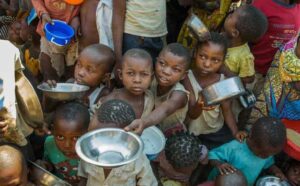By: JENTRICE MUNEI
1. Drought: The Silent Dropout Catalyst
~School one day, homebound the next
In 2022, a staggering 99% of school dropouts in Kajiado Central cited drought related reasons from fetching water, grazing livestock, to tending to dying herds according to CARE Kenya.
~Hollow classrooms and empty desks
By mid 2025, over 300 learners hadn’t returned to term three, especially in rural areas where livestock sales fund education. In some schools, only one third of students came back after the holidays.
2. Poverty: Fees, Food, and Forced Choices

~No livestock, no lunch
With herds decimated, parents can no longer pay fees nor feed their children. Many resort to picking up casual work or hawking a short term fix for survival.
~Hunger before homework
Around 84% of attending students suffer from hunger induced fatigue, showing short attention spans and even sleeping in class.
3. Wild & Wilderness: Learning at the Mercy of Giants
~Elephants at the gate
In 2025, eight schools shut for three weeks after elephant invasions when wild elephants raid compounds, teaching stalls, and safety erodes.
~Daily fear, delayed education
Children wait until mid morning to avoid wild encounters, disrupting learning routines.
4. Girls at Risk: Pregnancies and Displacement

~Alarming dropouts among girls
Teenage pregnancies have sidelined many girls by 2021, 25% of dropouts in Kajiado South were girls, largely citing early pregnancies and marriage.
~Re entry is not simple
Initiatives by FAWEK engage stakeholders in re entry programs. Safe hubs in Kitengela nurture teen moms before reintegration, yet the road is long and winding
.
>Rays of Hope: Community & NGO Solutions
~Feeding programs
Organizations like Light of Hope now feed 79,000 pupils across 210 schools, lifting enrollment from 84% to 97% (2022–2024).
~Door to door tracing missions
Chiefs, elders, and NGOs collaborate to trace and re enroll absent learners through mop up drives initiated after low transition rates.
~Parental empowerment workshops
Through engagements under shade at ECDE centers, parents are learning CBC curricula and actively participating in schooling buying books, attending meetings, and nurturing progress.
>Closing the Disparity Loop
Despite policies guaranteeing free basic education, structural dynamics drought, poverty, gender bias, and ecological hazards open cracks too wide for many children to cross. But Kajiado isn’t giving up. From feeding programs to parental empowerment, community patrol teams to wildlife fencing, a mosaic of interventions offers hope.
~Ending on a Dare: Can We Make Education Elastic?
Imagine a system so adaptable that no mattress less Maasai child, no hungry teenager, no rural outlier is left stranded. Education must stretch to meet them the drought stricken grazing lands, the elephant corridors. Because when the classroom becomes a mirage, chasing down every learner is not just a moral duty it’s the foundation of Kenya’s future.
Kajiado’s hard to reach children are knocking. Will we let them walk away?

